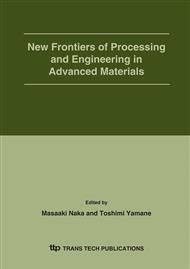p.431
p.437
p.443
p.449
p.455
p.461
p.467
p.473
p.481
Estimation of Mechanical Properties of Al/Cu Compound Layer Formed by Impact Welding
Abstract:
The impact welding of aluminum onto copper was carried out using a gas gun and the mechanical properties of Al/Cu joint were investigated by tensile tests and micro hardness indentation tests. The strength measured by tensile test decreased with increasing of the impact velocity. The results of the tensile test suggested that it was necessary to make a microscopic survey of the joint interface. Then, the inverse analysis with FEM analysis was applied to the load and depth curves measured by the indentation technique to identify the material constants in the constitutive equations of aluminum, copper and the compound layer. In addition, the numerical simulation for the tensile test was carried out using the identified material constants of aluminum, copper and the compound layer. The nominal stress-strain curve of the compound layer obtained by the numerical simulation showed the typical feature of brittle material. The ultimate tensile stress of the compound layer was about 1.2 GPa and ten times larger than that of aluminum. It was concluded that the bonding strength of Al/Cu joint was dependent on the integrity of the compound layer.
Info:
Periodical:
Pages:
455-460
Citation:
Online since:
December 2005
Authors:
Price:
Сopyright:
© 2005 Trans Tech Publications Ltd. All Rights Reserved
Share:
Citation:


